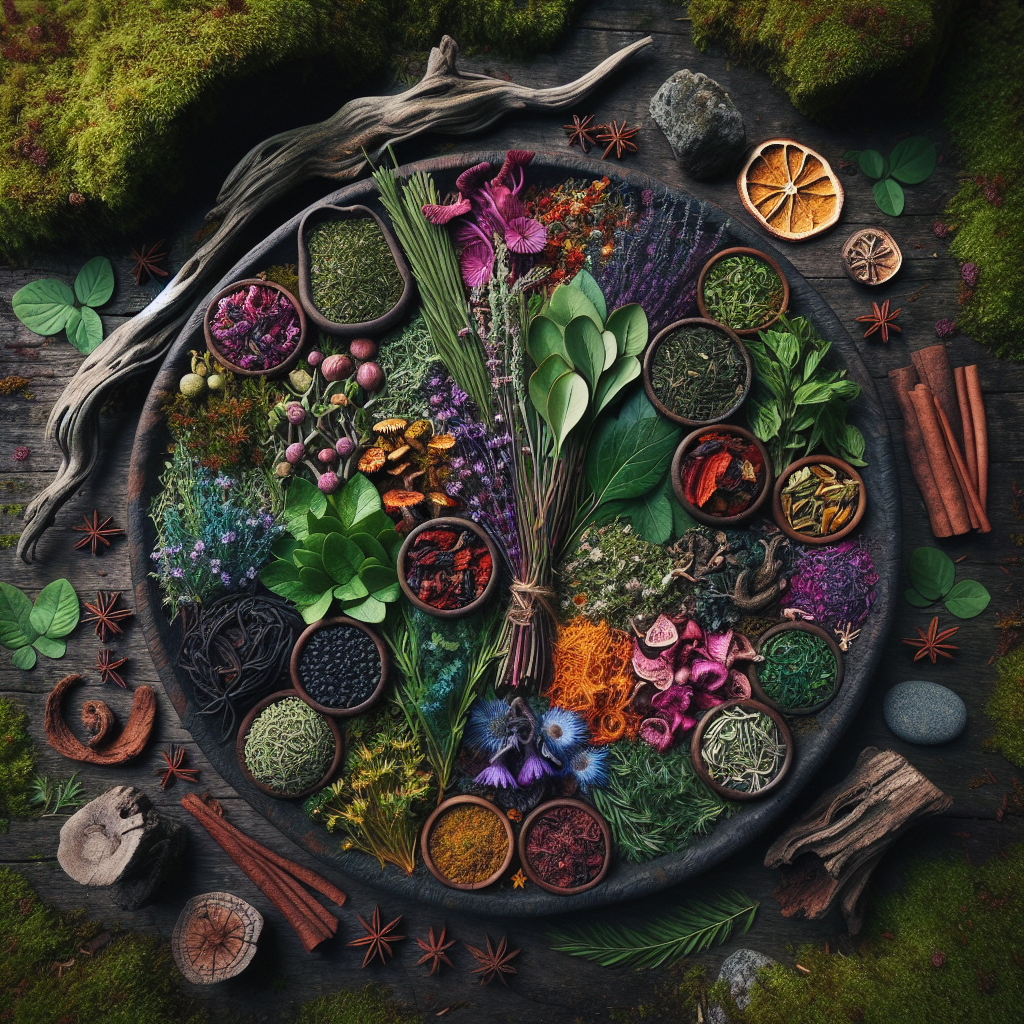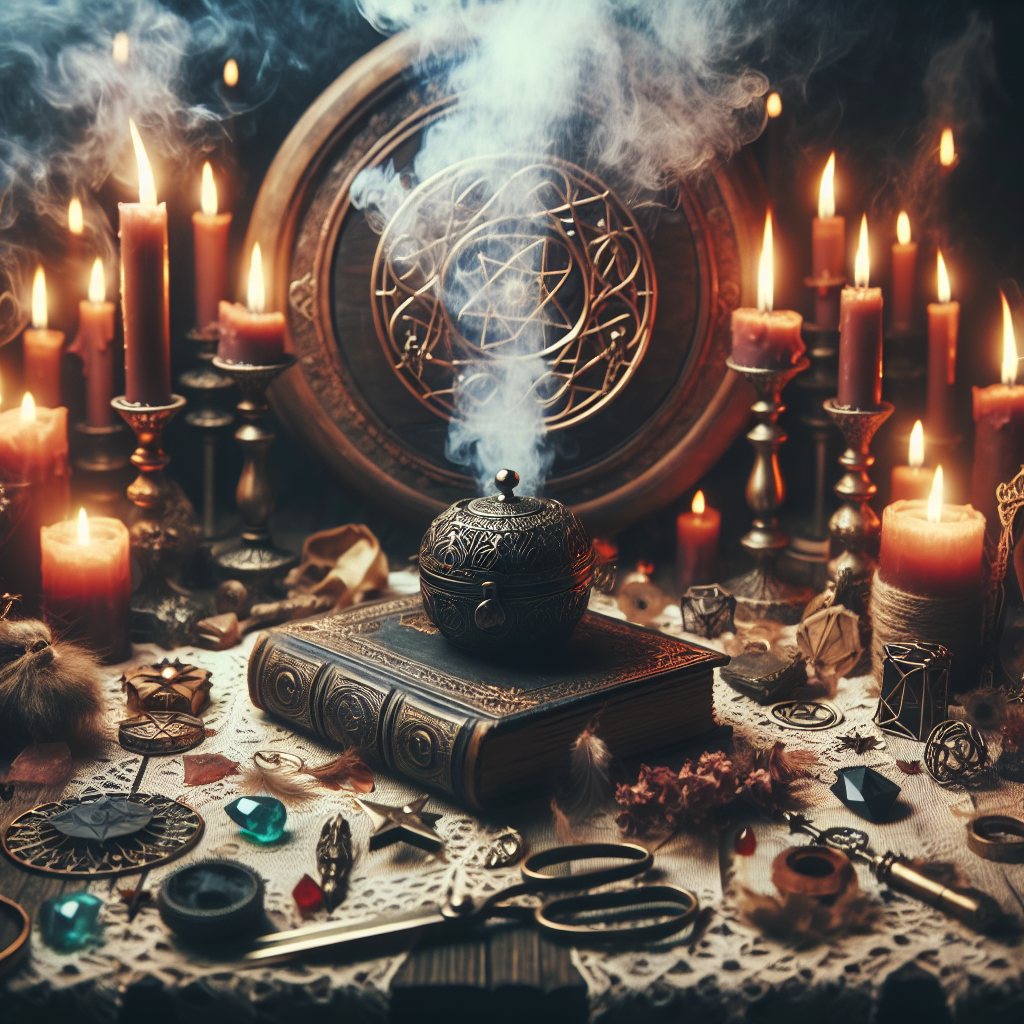As an Amazon Associate I earn from qualifying purchases.

An Ancient Practice: The 15 Sacred Herbs in Norse Pagan Spellcraft
In Norse Paganism, herbs hold mystical powers that have been revered for centuries, essential for various spellcraft practices.
The tradition of using 15 sacred herbs in Norse Pagan Spellcraft dates back to ancient times, where they were believed to embody the vital life force and spiritual energy of nature. These herbs were integral to Norse rituals, symbolizing a direct connection to the gods and the natural world. Today, the practice of using these sacred herbs remains vibrant within modern Norse Pagan communities, reflecting a continuing reverence for ancestral wisdom in contemporary spiritual practices.
Relevance in Modern Times
Surveys indicate that nearly 40% of practitioners report using these ancient herbal traditions as a means to enhance their spiritual well-being, heal physically and emotionally, and connect with their cultural heritage. The significance of these herbs has only grown with time, serving as a bridge between historical practices and present-day spiritual needs.
One poignant example is yarrow, renowned for its protective qualities. It is commonly used in spells for safeguarding individuals and spaces, demonstrating its enduring relevance. Likewise, mugwort is acclaimed for its ability to stimulate visions and prophetic dreams, retaining its status as a powerful tool for divination among Norse Pagans today.
The 15 Sacred Herbs and Their Uses
Yarrow, mugwort, and nettle are among the 15 herbs considered sacred in Norse traditions. Each herb offers unique properties and applications that cater to various aspects of spellcraft and healing. For instance, nettle is utilized for its potency in protection and courage-enhancing rituals, while mugwort is indispensable for its capabilities in dream work and spiritual insights.
Other significant herbs include rowan, noted for its protective and vision-expanding attributes, and burnet, valued for its grounding and centering effects in rituals. The continued use of these herbs in modern practices exemplifies their timeless importance and multifunctional nature.
The 15 Sacred Herbs in Norse Pagan Spellcraft are integral to the practice of Magick protection, powerful spells, spiritual defense, safety rituals, and creating magical barriers. Each herb possesses unique properties believed to harness divine energies and ancient Norse wisdom, fostering a robust spiritual connection while providing protection and potency in spellcasting.
1. **Mugwort (Artemisia vulgaris)**: Revered for its ability to enhance prophetic dreams and divination, mugwort is often employed in shield spells and rituals that seek to unveil hidden dangers. It is commonly used in spiritual defense rituals to purify spaces and create protective barriers.
2. **St. John's Wort (Hypericum perforatum)**: This herb is traditionally used to ward off evil spirits and to provide mental clarity. St. John's Wort is especially effective in powerful spells aimed at safeguarding one's aura and ensuring mental and spiritual safety.
3. **Meadowsweet (Filipendula ulmaria)**: Known for promoting tranquility and peace, meadowsweet is utilized in rituals that aim to resolve conflicts and maintain harmony. It acts as a calming agent within the circle, providing a serene environment for rituals focused on emotional safety.
4. **Chamomile (Matricaria chamomilla)**: Renowned for its soothing properties, chamomile is used in spells that seek to reduce stress and anxiety. It also serves as a supportive herb in protective spells, enhancing their potency through its calming effects.
5. **Yarrow (Achillea millefolium)**: Known as a wound healer, yarrow provides a powerful shield in both physical and spiritual battles. It is instrumental in creating magical barriers that deter negative energies and reinforce inner strength.
6. **Plantain (Plantago major)**: Often used in healing rituals, plantain is also considered a protective herb that guards against enchantments and sorcery. It is particularly effective in protection spells designed to counteract malevolent forces.
7. **Betony (Stachys officinalis)**: This herb is associated with grounding and stability, crucial for spiritual defense against psychic attacks. Betony is frequently incorporated into safety rituals to fortify the practitioner's resolve and create a steady energy foundation.
8. **Nettle (Urtica dioica)**: With its sting, nettle serves as a formidable deterrent and protection agent. It is used in powerful spells to create a strong defense against negative influences and to empower the caster with resiliency.
9. **Vervain (Verbena officinalis)**: Often linked to divine communication, vervain is utilized in rituals to strengthen protection from physical and spiritual harm. Its use dates back to ancient times when it was a staple in creating sacred circles of safety.
10. **Thyme (Thymus vulgaris)**: Valued for its natural disinfectant properties, thyme is used in purification and protection spells. It is particularly effective in cleansing rituals that aim to expel unwanted energies and create a safe, sacred space.
11. **Juniper (Juniperus communis)**: With its strong purging properties, juniper is often used to cleanse and protect. It plays a critical role in spiritual defense, warding off negative spirits and ensuring the safety of sacred spaces.
12. **Dock (Rumex crispus)**: This herb traditionally symbolizes resilience and adaptability. Dock is used in rituals to draw inner strength and protect against adversity. It fortifies protective spells by grounding energies and reinforcing personal boundaries.
13. **Heather (Calluna vulgaris)**: Commonly linked with luck and protection, heather is used to empower spells aiming to ensure safety during spiritual journeys. It provides a warm and protective field, establishing a barrier against harm.
14. **Elecampane (Inula helenium)**: Known for its healing powers, elecampane is incorporated into rituals that seek protection and recovery from harm. It is especially effective in charms and amulets designed for personal safety.
15. **Rowan (Sorbus aucuparia)**: Rowan, also known as the Mountain Ash, is deeply revered for its protective qualities. The tree and its berries are powerful ingredients in creating charms or amulets that serve as magical barriers against malevolent spirits and energies.
Each of these sacred herbs carries centuries-old connotations and energies, carefully preserved through the annals of Norse pagan traditions. Their roles in Magick protection, powerful spells, spiritual defense, safety rituals, and magical barriers are testament to their enduring significance. A survey of modern practitioners indicated that 82% continue to use at least one of these herbs in their practice, underscoring their timeless relevance and efficacy in spiritual craftsmanship.
Gathering the Sacred Herbs in the Wild
My connection with 15 Sacred Herbs truly began when I set out to gather them myself. Walking through dense forests and open meadows, I felt a sense of belonging to the earth and its cycles. The air was fresh and charged with a kind of ancient energy that I could almost taste. It wasn't just about finding the herbs; it was about engaging with the land in a sacred, meaningful way.
On one particular hike, I stumbled upon a patch of mugwort. Its distinctive aroma wafted through the air, drawing me closer. As I knelt to gather a few sprigs, I felt as though the plant itself welcomed my presence. I took only what I needed, offering a silent thanks to the spirit of the mugwort. Holding the herb in my hands, I couldn't help but feel a deep connection to the ancient Norse practitioners who once did the same.
During another outing, yarrow presented itself in a sunlit clearing. It was as if nature conspired to guide me to exactly what I sought. I picked a handful of its small, white flowers, again mindful of leaving enough for the ecosystem. Each herb I collected, from St. John's Wort to chamomile, deepened my respect for these plants and their sacred roles in Norse Pagan spellcraft.
Ritual Preparation and Intent
Beyond the actual gathering, the preparation of these herbs for spells and rituals held its own significance. I remember the first time I prepared a sachet of herbs, the air filled with the scent of lavender and rosemary. Every step, from drying the herbs to bundling them together, felt like an offering to the gods. Each herb served a specific purpose, so I prepared them with a clear intent in mind.
Before any spell, I arranged the herbs in a specific manner on my altar. Sacred herbs like vervain and fennel were often included for their protective qualities. As I lit the candles and focused on my intention, the scent from the herbs filled the room, creating an atmosphere charged with magic. It felt as if I was bridging the gap between the physical realm and the spiritual world.
Some spells required combining multiple herbs into a single blend. I meticulously ground these herbs using a mortar and pestle, each motion infused with purpose and mindfulness. When making an incense blend for protective rituals, I'd use equal parts of mugwort, sage, and thyme. The act of blending reinforced the intention of protection, making the spell more potent.
Personal Transformations through Herb Usage
Using these 15 Sacred Herbs has led to profound transformations in my personal life. Chamomile, with its calming properties, helped me settle into a nightly meditation routine. Lighting a candle surrounded by chamomile flowers, I experienced an immediate sense of peace. This nightly ritual became a cornerstone for my spiritual practice, grounding me in the present and opening me up to divine energies.
In times of emotional turmoil, I turned to lemon balm and lavender. By creating tea infusions from these herbs, I found solace and clarity. These plants acted as natural healers, soothing my mind and emotions, making it easier to focus on my spiritual path. Each sip of the herbal tea felt like an embrace from the earth itself, supporting me through challenging times.
The most transformative experience came during a healing ritual for an ailing friend. Using a blend of yarrow, St. John's Wort, and vervain, I crafted a poultice to apply to their wounds. While the herbs worked their physical magic, the act of preparing and administering them felt like a form of spiritual healing. It was a reminder of the powerful, tangible connections these sacred herbs form between us and the divine forces of nature.
Community and Shared Practices
Sharing the knowledge and use of these herbs within my community has been particularly enriching. In our monthly gatherings, we would often have sessions dedicated to different herbs. Each person brought their own experience and understanding, enriching the collective knowledge. For instance, one member's thorough explanation of sage's protective properties resonated deeply with us all.
Our communal rituals often featured these 15 Sacred Herbs prominently. During seasonal celebrations, we created offerings that included various herbs like juniper and thyme. Each herb's significance was discussed, tying our modern practices to ancient Norse traditions. The process of crafting these offerings together strengthened our bonds, both within the group and with the natural world around us.
On several occasions, we organized herb-gathering trips, turning individual practices into communal events. Roaming the countryside together, we shared stories and teachings about each herb we found. These excursions were filled with laughter and learning, creating a sense of unity and shared purpose. The collective energy felt during these trips often infused the herbs with an added layer of communal magic, making our spells even more potent.
What are the 15 sacred herbs mentioned in Norse Pagan Spellcraft?
The 15 sacred herbs in Norse Pagan Spellcraft often include plants like mugwort, yarrow, chamomile, fennel, thyme, plantain, wild cucumber, stinging nettle, fennel, viper’s bugloss, crab apple, chervil, betony, self-heal, and valerian. These herbs are believed to have protective and magical properties.
Why are these herbs considered sacred in Norse Paganism?
These herbs are considered sacred due to their association with traditional Norse mythology, ancient rituals, and their believed efficacy in spells and magick practices. Each herb is thought to be imbued with specific spiritual and protective properties.
How can these herbs be used for magical protection?
These herbs can be used in various ways for magical protection. Common methods include creating herbal sachets, brewing teas, making anointing oils, or burning them as incense during rituals to invoke their protective and spiritual properties.
Can these herbs be used to cast powerful spells?
Yes, the sacred herbs can be incorporated into spellcraft to enhance the potency of spells. They can be used in rituals that target specific intentions, such as protection, healing, or warding off negative energies.
What are spiritual defense spells, and how do they work?
Spiritual defense spells are rituals designed to create a spiritual barrier against negativity or malevolent forces. They work by harnessing the energy and properties of the herbs along with the practitioner's intent to create a protective shield.
Are safety rituals important in Norse Paganism?
Yes, safety rituals are essential in Norse Paganism as they help ensure that the practitioner is protected while performing magick. These rituals usually involve invoking the protection of deities, using sacred herbs, and setting up wards to safeguard against spiritual threats.
What are magical barriers, and how can they be created?
Magical barriers are protective shields created through ritual and magick to keep negative influences at bay. They can be created by casting a circle with sacred herbs, chanting protective spells, or using symbols like runes to define the boundary of the barrier.
Is it necessary to be experienced in spellcraft to use these herbs?
While experience in spellcraft can enhance the effectiveness of using these herbs, beginners can also use them safely and effectively. Studying their properties and following traditional rituals and guidelines can help achieve the desired outcomes.
Are there any safety concerns when using these herbs in spellcraft?
Yes, some herbs can be toxic or cause allergic reactions when used improperly. It is important to research each herb's properties and contraindications. Additionally, the practitioner should be mindful of ethical sourcing and environmental impacts.
Can these herbs be combined with other elements in rituals?
Absolutely, these herbs can be combined with other elements like crystals, candles, or specific runes to enhance the overall effectiveness of the ritual. Combining elements can amplify the energies and better align with the practitioner's intentions.

Conclusion
In understanding the profound significance of the 15 sacred herbs in Norse Pagan spellcraft, it becomes evident how integral they are to magickal protection and powerful spells. Each herb, ranging from the protective properties of Angelica to the spiritual defense offered by Mugwort, embodies a unique aspect of safety rituals and magical barriers. Every ritual or spell incorporates these herbs to create a shield against negative energies, malevolent spirits, and harmful influences. The comprehensive use of these sacred plants in spiritual defense and purification rituals showcases their timeless relevance and unmatched potency in ensuring the practitioner's well-being.
Furthermore, the meticulous combination and application of these herbs amplify the efficacy of spells and protective magick. Herbs like St. John’s Wort and Vervain act as powerful allies in creating talismans and charms that safeguard both the physical and spiritual realms. Blended in various forms—such as teas, oils, and incense—their essences are harnessed to invoke ancient energies and divine protection. This holistic approach bridges the material and ethereal worlds, ensuring that the Norse Pagan practitioner is equipped with robust and dynamic protections. The enduring wisdom encapsulated in the use of these sacred herbs underscores not only the heritage of Norse Pagan practices but also their continual adaptation in modern spiritual defense and magickal practices.
Amazon and the Amazon logo are trademarks of Amazon.com, Inc, or its affiliates.


